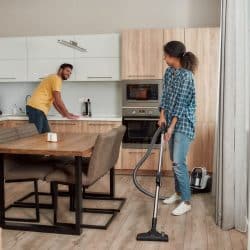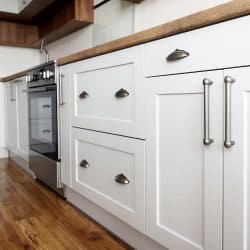Changing the color or texture of your kitchen floor by painting it can be the ultimate kitchen remodel, and give it a more open and inviting appearance. If you're considering painting your kitchen floor, you might be wondering how to go about it. Well, you've come to the right place. We've researched the best way to paint a kitchen floor, and in this post, we'll cover how to do it.
Here are the steps to paint your kitchen floor:
- Prepare the flooring
- Repair damaged areas
- Apply painter's tape
- Apply a primer
- Paint the floors
The most important thing to remember before taking on this type of project is that a good paint job will result from good preparation. It's best to list all the tools you need for the task and carefully prepare the floor before applying the paint and primer. Please continue reading to learn more about the steps to get it done.
![worker using a paint roller with extension to paint the kitchen floor. How To Paint The Kitchen Floor [A 5-Step Process]](https://kitchenseer.com/wp-content/uploads/2021/07/worker-using-a-paint-roller-with-extension-to-paint-the-kitchen-floor.-How-To-Paint-The-Kitchen-Floor-A-5-Step-Process.png)
Steps To Paint The Kitchen Floor
Things you'll need:
- Paint
- Paint roller
- Angled paintbrush
- Tape
- Primer
- Utility knife
- Cleaning towels
- 2-gallon bucket
- Mop
- Orbital sander
- Broom
- Paint thinner

1. Prepare the flooring
Start by clearing everything from the kitchen floor, including any furniture, personal items, or cleaning tools. Next, scuff up your floor with the orbital sander. If you have hardwood floors, use a 200-grit disc. Use a 150-grit disc if you have laminate our floors that are already painted. This will ensure a quality adhesion once you apply the paint.
Afterward, remove any sanding dust with a broom or vacuum with a hose attachment.
Check out this vacuum on Amazon.
2. Repair damaged areas
Now's the time to closely inspect the floor to see if there are areas that have dents, holes, or scratches. If so, it's best to use a filler to repair them. If your floor is wood, it's best to use a wood filler, and if you are floor is tile, you can use a ceramic tile mastic. Use a putty knife to apply the repairing agent and then let it dry for the recommended time.
After it's dried, use a sanding block or orbital sander for sanding it down so that it's flush with the rest of the floor's surface. Next, wipe down the area with a damp cloth or go over it with a damp mop to remove all traces of dust.
3. Apply painter's tape
Next, take painter's tape and apply it to the bottom of the walls so that you'll avoid accidentally painting this area. You can also use your putty knife to place the bottom of the tape between the crack of the floor and the wall.
4. Apply a primer
Gently agitate the can of primer it for about 15 seconds. Next, pour it into the paint tray and then apply it to the floor. Starting around the corners, apply the paint using your angled paintbrush. Also, be sure to start at the corner farthest away from the door and work your way around clockwise. After you have edged-in the corners with your paintbrush, go over the entire floor with your paint roller.
Check out this primer on Amazon.
5. Paint the floors
After the primer has dried, which can take anywhere from two to four hours, break out your paint can and stir it with a paint stirrer for a few seconds. Next, pour about 16 ounces of paint into the paint tray. Then, take your angled brush and, starting from the wall farthest away from the door, apply the paint to the floor's perimeter.
Next, use a paint roller with an extension pole to apply the paint to the rest of the floor, starting in the same corner. It's best to work with a roller that has at least a 3/8-inch nap to avoid having to put extra pressure on the roller for good adhesion. Check your paint can for the proper drying time and apply additional coats as needed.
Check out this paint on Amazon.
What do I need to paint my kitchen floor?
Before you can paint your kitchen floor, you'll first need to determine what type of paint to use. This will likely depend on the type of flooring you have and whether it's wood, laminate, ceramic, or vinyl. We've got more about paint types straight ahead.
You'll also need typical painting tools, including a brush, roller, wand extension, trays, primer, cleaning rags, and painter's tape. It helps make a list of the materials before heading to the store as it can be extensive. This way, you won't have to go back once you're ready to start your project.
What kind of paint do you use on the kitchen floor?
The type of paint you use on the floor depends on the type of flooring material you have. Let's look at the most common types of floor paint used.
Chalk paint
Chalk paint is a paint that will work on most flooring materials, wood particularly. You can also use chalk as a base coat before applying your primer and topcoat of paint.
Chalk paint has a thick, chalk-like consistency and can add a bit of texture to your floors, particularly if you want to do any patterns with overlays. Sometimes it also helps add a top coat to chalk paint, especially if you are looking to have a glossy finish.
Check out this chalk paint on Amazon.
Latex-based paint
Latex paint works well for ceramic, wood, and vinyl floors. The biggest advantage of latex paint is that it will dry relatively quickly and way faster than most oil-based paints. It also provides a nice high gloss or semi-gloss finish for solid or patterned tiles.
If you are looking for a more modern look for your floors, this gives you more options. New latex paints are also holding up better than they did years ago, which has helped them compete more with oil-based paint when it comes to longevity and durability.
Read more details about this latex paint on Amazon.
Oil-based paint
In the long run, you'll find that oil-based paint will hold up a bit better than latex. It's also great at resisting damage from foot traffic, especially when you apply two or three coats. If choosing an oil-based paint, it's best to go with a semi or high-gloss option to help improve stain resistance and ease cleaning.
Find this oil-based paint on Amazon.
Can you paint over kitchen floor tiles?
Yes. You can paint over kitchen floor tiles. It's best to first consider the porosity of the tiles before deciding to paint over them. Some surfaces are more porous than others (such as sealed ceramic tiles versus non-sealed), which can affect the finished look.
You'll also need to determine which primer will work best for the floor to ensure that you'll have proper adhesion before applying the paint.
What color should I paint my kitchen floor?
Depending on the look you want to achieve and other factors to consider, including the color of the walls, counter, and other appliances, it's best to find a floor color that compliments the rest of the room's pallet. So whether you're looking for something that will be a stark contrast or something that helps flow with the room's palette, it's best to find a matching color that presents a complimentary visual interest.
It helps to note that dark tiles such as greens, blues, and browns can make the room look a bit smaller but present a warmer and cozier visual interest. Whereas lighter colors such as greys, creams, and whites can open up the room, make it look brighter, and go perfectly with dark appliances and wall colors.
It also helps to consider adding texture and patterns to the tile to make the floor more interesting. For example, you can use subway, scalloped, or etched tiles to add more visual elements to the floor. This way, you can bring more attention to the floor, as it's in the area that generally is overlooked in comparison to other surfaces.
Wrapping Things Up
Painting a kitchen floor is a great way to add texture and modernity to the room. Remember, the most important thing when it comes to painting is doing a great preparation job. This means making sure that you properly sand the floor and apply the primer thoroughly. This way, you'll have an even and smooth final finish.
Before you go, be sure to check out our other posts:
10 Fantastic Bamboo Food Containers You Should Check Out
How Many Wine And Cocktail Glasses Should You Have?











![Stretch ceiling in the kitchen with installed and included spotlights. What Paint Finish Is Best For Kitchen Ceiling [3 Suggestions]](https://kitchenseer.com/wp-content/uploads/2021/09/Stretch-ceiling-in-the-kitchen-with-installed-and-included-spotlights.-What-Paint-Finish-Is-Best-For-Kitchen-Ceiling-3-Suggestions-250x250.png)
![An ultra modern kitchen with a granite countertop, gray appliances, and wooden vinyl flooring, How to Paint Granite Countertops [15 Steps Guide]](https://kitchenseer.com/wp-content/uploads/2020/10/An-ultra-modern-kitchen-with-a-granite-countertop-gray-appliances-and-wooden-vinyl-flooring-250x250.jpg)

